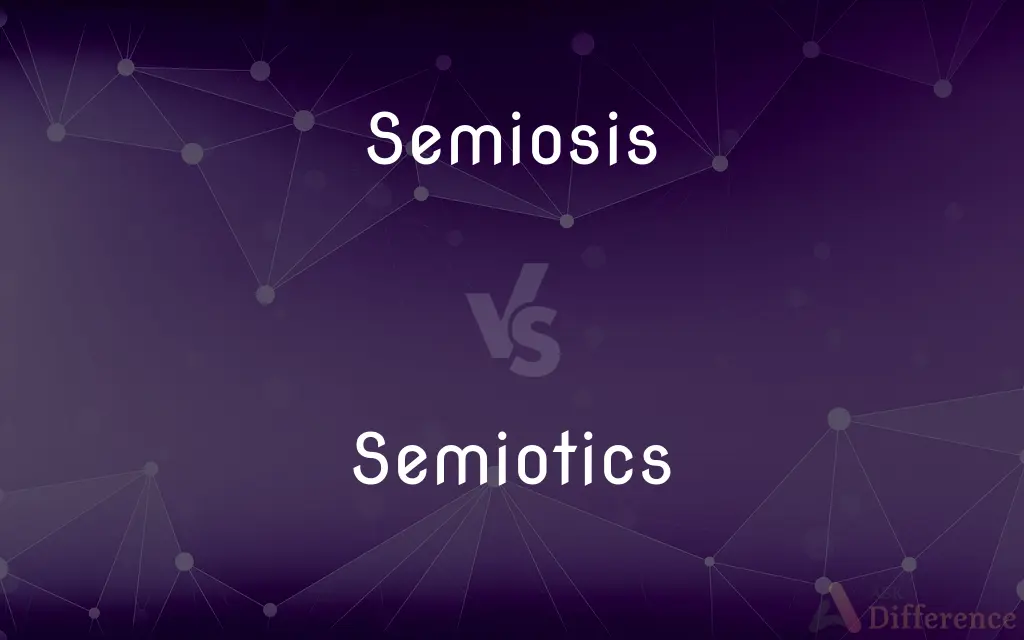Semiosis vs. Semiotics — What's the Difference?
Edited by Tayyaba Rehman — By Maham Liaqat — Updated on April 8, 2024
Semiosis refers to the process of signification or meaning-making in various forms of communication, whereas semiotics is the study of signs and symbols, their use and interpretation.

Difference Between Semiosis and Semiotics
Table of Contents
ADVERTISEMENT
Key Differences
Semiosis is a foundational concept in the field of semiotics, representing the process through which meaning is created and interpreted through signs. It encompasses the dynamic relationship between a sign, its object, and its interpretant. On the other hand, semiotics is an academic discipline that systematically studies how signs operate, how meanings are constructed and understood, and the various systems and processes, including semiosis, that underlie communicative acts.
Semiosis highlights the active, ongoing process of meaning-making that occurs in human interactions, literature, art, and all forms of communication. It emphasizes the interpretative nature of understanding, suggesting that meaning is not fixed but continuously generated and regenerated through context, experience, and interaction. Whereas semiotics provides the theoretical framework and tools for analyzing these processes, offering insights into the mechanics of how meaning is conveyed and perceived through signs.
In semiosis, the focus is on the triadic relationship—sign, object, and interpretant—as proposed by Charles Sanders Peirce, demonstrating how signs come to represent objects not inherently but through the interpretive actions of individuals or communities. Semiotics, while encompassing this understanding, also investigates the broader implications of sign systems, including language, gestures, images, and symbols, across different cultural and social contexts.
The study of semiotics encompasses various theories and methodologies for analyzing sign systems, including the distinctions between types of signs (icons, indexes, and symbols), the roles of codes and conventions in interpretation, and the impact of cultural and social factors on semiosis. In contrast, semiosis itself is a concept within this discipline, serving as a key mechanism by which semiotics explains the creation and interpretation of meaning.
Understanding semiosis is crucial for applying semiotic theories to practical analyses of communication and cultural phenomena. It provides a lens through which the dynamic, evolving nature of meaning can be explored. Meanwhile, semiotics offers a broader disciplinary context, providing the tools, concepts, and theoretical frameworks necessary for systematic study and interpretation of signs and symbols in all aspects of human life.
ADVERTISEMENT
Comparison Chart
Definition
The process of signification or meaning-making.
The study of signs and symbols, and their use and interpretation.
Focus
On the dynamic process of creating and interpreting meanings.
On the systems, theories, and methodologies for analyzing sign processes.
Key Concepts
Sign, object, interpretant.
Sign systems, codes, conventions, types of signs (icons, indexes, symbols).
Theoretical Basis
Originates from Charles Sanders Peirce's work.
Encompasses works from various theorists, including Peirce, Saussure, and others.
Application
Central to understanding how communication and interpretation work.
Provides frameworks for analyzing cultural, social, and communicative phenomena.
Compare with Definitions
Semiosis
A process involving a sign, its referent, and the interpretation.
In literature, semiosis allows readers to find depth in characters' actions.
Semiotics
Analyzes how communication functions.
In semiotics, a gesture's meaning can be as significant as that of a spoken word.
Semiosis
Dynamic meaning-making in communication.
Art relies on semiosis to convey complex emotions and ideas.
Semiotics
Explores the role of signs in human interaction.
Advertising uses semiotics to create powerful brand symbols.
Semiosis
Continuous interpretation and re-interpretation of signs.
Language evolves through semiosis as new meanings emerge.
Semiotics
The discipline studying signs and their meanings.
Semiotics examines how words can signify objects or concepts.
Semiosis
The act of creating meaning through signs.
The semiosis of a red light involves recognizing it as a sign to stop.
Semiotics
Investigates sign systems across cultures.
Semiotics reveals how cultural contexts influence the interpretation of signs.
Semiosis
The foundation of how signs function in society.
Cultural symbols undergo semiosis to embody collective values.
Semiotics
Theoretical approach to understanding signs.
Semiotics provides tools for analyzing visual art's symbolic language.
Semiosis
Semiosis (from Ancient Greek σημείωσις (sēmeíōsis), from σημειῶ (sēmeiô) 'to mark'), or sign process, is any form of activity, conduct, or process that involves signs, including the production of meaning. A sign is anything that communicates a meaning, that is not the sign itself, to the interpreter of the sign.
Semiotics
Semiotics (also called semiotic studies) is the study of sign processes (semiosis), which are any activity, conduct, or process that involves signs, where a sign is defined as anything that communicates a meaning that is not the sign itself to the sign's interpreter. The meaning can be intentional such as a word uttered with a specific meaning, or unintentional, such as a symptom being a sign of a particular medical condition.
Semiosis
(semiotics) Any activity, conduct, or process that involves signs, including the production of meaning.
Semiotics
The theory and study of signs and symbols, especially as elements of language or other systems of communication, and comprising semantics, syntactics, and pragmatics.
Semiotics
The study of signs and symbols, especially as means of language or communication.
Social science
Semiotics
(dated) The study of medical signs and symptoms; symptomatology.
Semiotics
Same as Semeiotics.
Semiotics
(philosophy) a philosophical theory of the functions of signs and symbols
Common Curiosities
Can semiotics be applied to non-verbal communication?
Yes, semiotics analyzes all forms of communication, including non-verbal ones like gestures, images, and symbols, through its theories and methodologies.
Why is the study of semiosis important in semiotics?
Studying semiosis is crucial for understanding the dynamic, interpretative nature of meaning-making, which is central to semiotics' investigation of sign systems.
Can semiotics help in understanding cultural differences?
Yes, by analyzing how different cultures interpret signs and symbols, semiotics can provide insights into cultural differences and similarities.
What is semiosis?
Semiosis is the process through which signs convey meanings, involving the interaction between the sign, its object, and its interpretant.
What role does interpretation play in semiosis?
Interpretation is central to semiosis, as it involves understanding the meanings that signs convey in various contexts.
How does semiotics differ from linguistics?
While linguistics focuses specifically on language, semiotics covers a broader range of sign systems, including but not limited to linguistic signs.
How do semiosis and semiotics relate to each other?
Semiosis is a fundamental concept within semiotics, representing the process of meaning-making that semiotics aims to understand and analyze.
How has semiotics evolved as a field?
Semiotics has evolved to incorporate insights from various disciplines, including anthropology, psychology, and cultural studies, expanding its scope and methodologies.
What is an example of semiosis in everyday life?
Traffic signs exemplify semiosis in everyday life, where symbols convey specific instructions or information to drivers and pedestrians.
Why is semiotics important in marketing?
Semiotics is important in marketing for analyzing how brands use signs and symbols to communicate values, messages, and identities to consumers.
What is semiotics?
Semiotics is the study of signs and symbols, focusing on how meanings are created, conveyed, and interpreted in various contexts.
What are some key concepts in semiotics?
Key concepts include sign systems, types of signs (icons, indexes, and symbols), codes, and the cultural and social contexts of sign interpretation.
How do signs acquire their meanings according to semiotics?
According to semiotics, signs acquire meanings through social conventions, cultural contexts, and individual interpretations.
Can semiotics analyze digital media?
Yes, semiotics is used to analyze digital media, including websites, social media, and video games, examining how they create and convey meaning.
Share Your Discovery

Previous Comparison
Wrench vs. Shifter
Next Comparison
Desire vs. FantasyAuthor Spotlight
Written by
Maham LiaqatEdited by
Tayyaba RehmanTayyaba Rehman is a distinguished writer, currently serving as a primary contributor to askdifference.com. As a researcher in semantics and etymology, Tayyaba's passion for the complexity of languages and their distinctions has found a perfect home on the platform. Tayyaba delves into the intricacies of language, distinguishing between commonly confused words and phrases, thereby providing clarity for readers worldwide.
















































